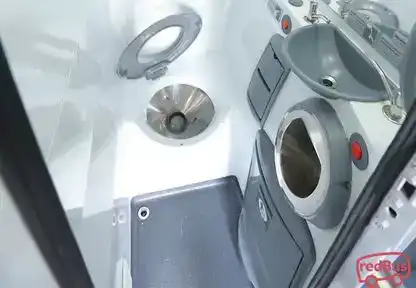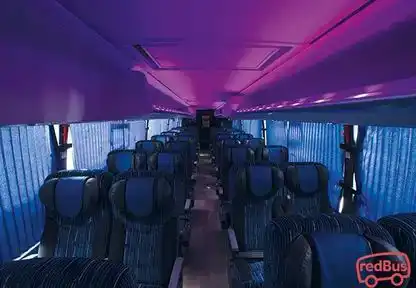Buy Bagua Grande to Lima Bus Tickets Online - Unlock Extra Savings with redDeals on redBus
Reserve a bus from Bagua Grande to Lima with redBus, Peru, and grab exclusive redDeals. Choose from 138 deals on 36 bus operators and avail yourself of discounts up to 25% on your bus travel!
Bagua grande to Lima Bus
The travel from Bagua Grande to Lima city takes about 22 hours by land, being a distance of 677 mi (1089 km). Civa is the transportation company that covers this itinerary, providing bus tickets at s/. 90 (s/. 110 if you choose the most exclusive service). Buses leave from the center of Bagua Grande at 3:00 p.m. and at 4:00 p.m., destination the terminals of North Lima and Center Lima in Lima city. The weather of Lima is varied, because it combines features of climates desert, humid and subtropical, with temperatures that can reach 84 °F (29 °C) in summer and can drop to 57 °F (14 °C) in winter.
Why book a Bagua Grande to Lima bus with redBus?
You can also time-to-time redBus offers while booking your bus tickets online from Bagua Grande to Lima. Follow a simple, fast and secure bus booking procedure. This helps save time and also helps to create a joyful travel experience!
About Bagua Grande
The former inhabitants of the region called this place Bagual Grande, with the passing of time, the city came to be known as Bagua Grande, current capital of the Utcubamba province. It was created as a district during the Independence campaign, the 12th of February of 1821, and for a long time it remained a rural area, although it has transformed into an active trade hub since the 60’s due to migrations and its strategic location as a gateway to the rainforest areas.
About Lima
"The City of Kings", as Lima is known, was founded in 1535 by Francisco Pizarro and became the center of Spanish power in Peru, during the colonial period.The urban planning of Lima is one of the colonial models in South America. Lima is known for its social, economical and cultural growth and stands out as the cultural center of Latin America; besides that, Lima is the home of San Marcos National University, the most ancient from America, founded in 1551.Lima is famous for being the viceroyalty capital of Peru and one of the cities most important of South America in the spanish regime period; after its independance in 1821 the city became the republic's capital. Before this period, the Baroque and Neoclassical style took the power on the streets, impregnating those architectural styles in the main constructions. The capital counts a high variety of tourist attractions that combine history and modernity, as you can see on the Historical Center. Another strong point of Lima is the food, there are many restaurants from the 3 Peruvian regions where you can live a complete gastronomical experience, given that the population is multicultural and mostly migrant. Live Peru from one of its corners, and enjoy tasting the culture that Peru offers you!
Lima, the capital of Peru, is a vibrant city known for its rich history, coastal landscapes, and world-renowned gastronomy. Visitors can explore colonial architecture, enjoy fresh seafood dishes like ceviche, and discover cultural landmarks such as Plaza Mayor, Miraflores, and Barranco.
Weather in Lima
Lima has a mild and humid climate throughout the year:
-
Summer (December - April): Temperatures range from 20°C to 30°C (68°F to 86°F), with sunny days.
-
Winter (May - November): Cooler temperatures between 14°C and 19°C (57°F to 66°F), with mist and high humidity.
Hotels in Lima
Casa Andina Premium Miraflores
-
Location: Av. La Paz 463, Miraflores.
-
Price: From S/ 350 per night.
-
Description: A modern hotel with comfortable rooms, a gym, and an excellent restaurant.
Selina Lima
-
Location: Av. Alcanfores 465, Miraflores.
-
Price: From S/ 150 per night.
-
Description: A stylish and budget-friendly hotel with a coworking space and bar.
Restaurants and Bars in Lima
Central
-
Location: Av. Pedro de Osma 301, Barranco.
-
Average Price: S/ 500+ per person.
-
Description: One of the world's top restaurants, offering a unique tasting menu inspired by Peru's ecosystems.
La Mar Cebichería
-
Location: Av. La Mar 770, Miraflores.
-
Average Price: Between S/ 80 and S/ 150.
-
Description: A popular seafood restaurant famous for its ceviche and tiraditos.
Gastronomy of Lima
-
Ceviche: Fresh fish marinated in lime juice, accompanied by corn and sweet potato.
-
Lomo Saltado: Stir-fried beef with onions, tomatoes, and fries, served with rice.
-
Pisco Sour: Peru’s iconic cocktail made with pisco, lime juice, and egg white.
Tourist Attractions in Lima
-
Plaza Mayor: The historical center with colonial buildings like the Government Palace and Cathedral.
-
Parque Kennedy: A lively park in Miraflores known for its cats and artisanal markets.
-
Huaca Pucllana: An ancient adobe pyramid located in the heart of Miraflores.
Important Dates in Lima
-
Peru’s Independence Day (July 28-29): Parades, fireworks, and traditional festivities.
-
Lima Anniversary (January 18): Celebrations with music and cultural events.
Things to Buy in Lima
-
Alpaca Wool Products: Sweaters, scarves, and ponchos made from high-quality alpaca wool.
-
Peruvian Coffee and Chocolate: Premium products from different regions of Peru.
-
Handcrafted Silver Jewelry: Unique designs inspired by Andean culture.
Bus Operators for the Route
Departure and Arrival Terminals
In Moquegua:
In Lima:

